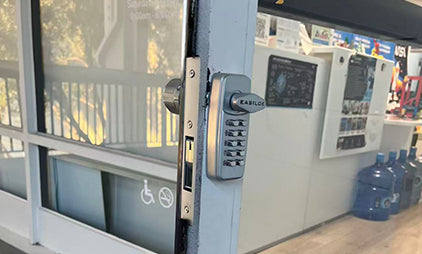
When and Why You Should Replace Your Storefront Lock
Share
Here’s how to identify when it’s time to replace your lock, and why doing it early can actually save you money and protect your business.
1. The Lock Feels Stiff or Loose
One of the most common warning signs is resistance or looseness when turning the key or pressing keypad buttons. Mechanical wear inside the cylinder can cause alignment problems, making it harder to operate the door smoothly.
If you need to wiggle the key or repeatedly press keypad buttons before the door unlocks, your lock is nearing the end of its lifespan. In these cases, it’s often better to replace it rather than repair it.
2. You’ve Experienced a Break-In or Attempted Break-In
Even if burglars didn’t succeed, an attempted break-in can damage the internal components of your lock. Hidden stress or bending can make the mechanism unreliable.
After any security incident, have a professional assess the lock and replace it if there’s any sign of compromise. A fresh lock like an Adams Rite replacement or Easilok mechanical keypad model can restore confidence and prevent further issues.
3. Lost or Stolen Keys
If a key to your store has been lost or stolen, replacing the entire lock (or at least rekeying it) is the safest move. Even one missing key can expose your business to theft or vandalism.
Keypad locks eliminate this problem by allowing you to simply change the access code rather than the hardware—a major reason why modern storefronts are switching from keyed systems to mechanical keypads.
4. Visible Rust or Corrosion
Outdoor locks are constantly exposed to humidity and temperature changes. When you start seeing rust around the latch, handle, or keyway, it means corrosion is likely spreading inside.
Once rust reaches internal springs or pins, the lock can suddenly seize up—potentially trapping you or your staff outside. At this point, replacement is more reliable than repair.
5. Employee Turnover and Security Updates
If you’ve recently had multiple staff changes or contractors with access to your store, it’s a good idea to update your locking system.
Keypad locks make this process simple—just reset the code instead of replacing keys. For mechanical locks, consider upgrading to a new commercial-grade model that supports restricted keyways, preventing unauthorized duplication.
6. Old Design or Outdated Standards
Older locks may not meet modern security or fire code standards. If your storefront uses a decades-old deadbolt or latch that’s no longer certified for commercial use, upgrading is not only safer but also helps avoid insurance complications in case of theft.
7. Frequent Repairs Are Adding Up
If you’ve called a locksmith more than twice in the last year for the same lock, it’s time to replace it. Repeated servicing often costs more than a new, high-quality lock.
Installing a durable product like the Easilok commercial lock ensures smoother operation and lower maintenance over time.
Conclusion
Replacing your storefront lock isn’t just a reaction to failure—it’s a strategic decision. By paying attention to early warning signs like stiffness, corrosion, or lost keys, you can upgrade your store’s security before an emergency strikes.
Modern mechanical keypad locks, such as the Adams Rite replacement series, offer long-term reliability and eliminate the hassle of lost keys. In the long run, proactive replacement keeps your business secure, professional, and worry-free.

